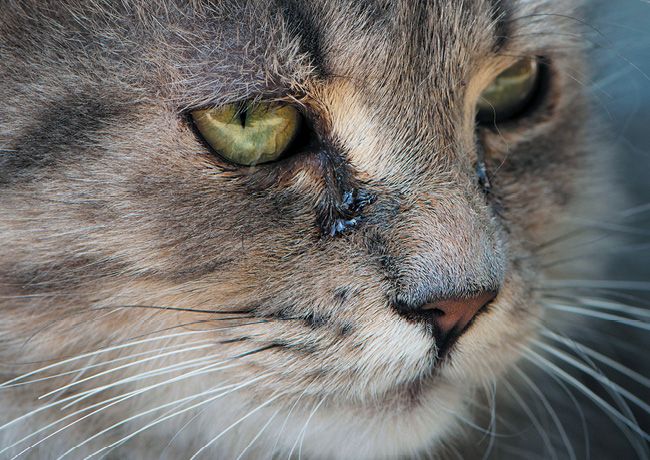Here and there a cat will develop an upper respiratory illness that makes it hard to breathe and can also cause wheezing, teary eyes, and nasal discharge. It typically passes within a week to 10 days. If it doesn’t, even with medical treatment, your cat may not have had an infection at all but, rather, has developed a polyp in her nose or at the back of her mouth, above her soft palate. This may be referred to as a nasal polyp or more technically, a nasopharyngeal polyp.
Polyps are uncomfortable for your pet. While a polyp is not cancerous, the fleshy mass can cause not only labored breathing but also sneezing and trouble swallowing. Consider that a nasal polyp can grow to almost an inch in size, and sometimes the polyps grow in small clusters of two or three.
Other indications that a polyp is present might be that a cat keeps shaking her head, tilting it from side to side, or pawing at her ears. Consider that nasopharyngeal polyps originate in the middle ear, and when they enlarge there are two directions in which they may grow. When they grow into the nasopharyngeal area they cause breathing issues. But when they grow into the external ear canal they cause ear issues. In some cats the polyp extends in both directions, causing both breathing and ear issues.
Why the polyps develop in the first place remains a mystery. A polyp will often occur in a cat who is anywhere from 1 to 4 years old, and some have posited that it results from inflammatory processes that were put into play when the cat had a respiratory infection as a kitten. There may also be a hereditary component. But the exact cause remains elusive.
A proper diagnosis
Sometimes a veterinarian will be able to see a nasal polyp on examination, although that generally means the cat must be under sedation. The areas to look for polyps are too sensitive for a cat to be cooperative. In other cases, imaging such as x-rays are necessary. And in some instances a camera will need to be sent into the nostrils (rhinoscopy) or down the throat (endoscopy) to allow for adequate visualization.
Treatment options
Once a polyp is identified, it has to be removed. It will not go away on its own and in fact will continue to grow, making the cat prone to ongoing problems. There are two main ways to remove it.
- Traction avulsion. This requires putting the cat under anesthesia and steadily pulling on the growth with small forceps. It works for many cats, although it is estimated that the polyp will regrow in up to 25 percent of cases.
Post-traction treatment generally includes administering antibiotics to deal with any possible infection. Oral steroids or ear drops may also be prescribed to cut down on the chance of recurrence.
- Surgery. Surgery is the way to go if the polyp extends into the ear (and cannot be completely removed through the ear canal) or if the polyp regrows after traction removal. This is a delicate surgery that must be performed by a board-certified veterinary surgeon.
The operation involves opening the middle ear so the polyp can be removed right where it originated. Surgery usually does the trick once and for all; the polyp doesn’t grow back. And the cat is back to herself in days, with very light post-operative care.
Once in a while, however, even with surgery, a polyp will grow back. That’s why some surgeons prescribe the steroid prednisolone after the procedure. It may help reduce the risk of regrowth.




